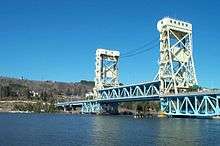Portage Lake Lift Bridge
| Portage Lake Lift Bridge | |
|---|---|
 | |
| Coordinates | 47°07′26″N 88°34′29″W / 47.123768°N 88.574706°WCoordinates: 47°07′26″N 88°34′29″W / 47.123768°N 88.574706°W |
| Carries |
|
| Crosses | Portage Waterway arm of Portage Lake |
| Locale | Hancock and Houghton, Michigan |
| Official name | Houghton–Hancock Bridge |
| Maintained by | MDOT |
| ID number | 3380 |
| Characteristics | |
| Design | Vertical-lift bridge |
| Total length | approx 500 feet (150 m) |
| Width |
upper deck: 4 lanes with no shoulders lower deck: 4 lanes with no shoulders, single-track railroad (abandoned 1982) |
| Height | 180 ft (55 m)[1] |
| Longest span | 250 ft (76 m) clearance |
| Clearance below |
4 ft (1.2 m) fully lowered 32–36 ft (9.8–11.0 m) raised to intermediate position About 100 ft (30 m) fully raised) |
| History | |
| Opened | 1959 |
| Statistics | |
| Daily traffic | >20,000[2] |
The Portage Lake Lift Bridge (officially the Houghton–Hancock Bridge[3]) connects the cities of Hancock and Houghton, in the US state of Michigan, across Portage Lake, a portion of the waterway which cuts across the Keweenaw Peninsula with a canal linking the final several miles to Lake Superior to the northwest. US Highway 41 (US 41) and M-26 are both routed across the bridge. It is the only land-based link between the north (so-called Copper Island) and south sections of the Keweenaw peninsula.[4]
The original bridge on the same site was a wooden swing bridge built in 1875. The bridge was built by James P. Edward of Fox and Howard Inc. of Chicago. Three local men raised $47,000 in stocks for the toll bridge. Construction began in the spring of 1875 and was finished in the spring of 1876.[5] This was replaced by a steel swing bridge, the Portage Canal Swing Bridge, built by the King Bridge Company in 1901. The Portage Canal Swing Bridge was damaged when a ship, the Northern Wave, collided with it in 1905. The center swinging section of the bridge was replaced and a similar incident almost occurred again in 1920, but the ship was able to stop by dropping its anchor, which snagged on the bottom of the lake. In 1959, the Portage Canal Swing Bridge was replaced, at a cost of about 11-13 million US dollars (sources vary), by the current bridge which was built by the American Bridge Company.[6]

This moveable bridge is a lift bridge with the middle section capable of being lifted from its low point of four feet clearance over the water to a clearance of 100 feet (30 m) to allow boats to pass underneath. The bridge is the world's heaviest and widest double-decked vertical-lift bridge.[7] More than 35,000 tons of concrete and 7,000 tons of steel went into the bridge, which replaced the narrow 54-year-old swing bridge, declared a menace to navigation on the busy Keweenaw Waterway.[8] Its center span "lifts" to provide 100 feet (30 m) of clearance for ships.
The original 1959 design by Hazelet and Erdal of Chicago of the bridge's liftspan had roadways constructed on both levels with rails imbedded in the road surface on the lower deck. This allowed the span to be partially raised to allow small and medium boat traffic to pass underneath without disrupting vehicular traffic. From this middle position, the span would then only need to be raised for large ships or lowered to allow trains to cross. With the end of rail service in 1982, the lowest position is no longer needed to allow trains to pass so the bridge is not lowered below the middle position during the summer boating season except for periods of maintenance or repair. In the winter after the lake freezes, the bridge is placed in the lowest position to allow the lower deck to be used by snowmobile traffic.[9]
Hancock and Houghton hold an annual celebration called Bridgefest to commemorate the opening of the bridge which united their two communities.[10]
Images
- The Portage Lake Lift Bridge at night
 Looking north while crossing bridge
Looking north while crossing bridge- Elevated to let boats pass underneath
References
- ↑ Hyde, Charles K. (1993). Historic Highway Bridges of Michigan. Great Lakes Books. Detroit: Wayne State University Press. p. 159. ISBN 0-8143-2448-7.
- ↑ "MDOT Unsure About Cause of Stuck Lift Bridge". The Daily Mining Gazette. Houghton, MI. August 5, 2010. OCLC 9940134. Retrieved August 5, 2010.
- ↑ Staff (May 10, 2002). "US 41 – Portage Lake". Michigan's Historic Bridges. Michigan Department of Transportation. Retrieved August 4, 2010.
- ↑ "Virtual Adventures". Keweenaw Convention and Visitors Bureau. Retrieved August 4, 2010.
- ↑ Smith, D (1986). "Houghton–Hancock Crossing". Michigan Tech Archives & Copper Country Historical Collections. pp. 1–13.
- ↑ "Portage Lake Bridge History". City of Hancock. 2005. Retrieved August 4, 2010.
- ↑ Staff. "Copper Country Trail: Portage Lake Lift Bridge, MI". America's Byways. Federal Highway Administration. Retrieved August 4, 2010.
- ↑ Forgrave, Mike; Forgrave, Tricia. "Portage Lift Bridge". Keweenaw Free Guide. Retrieved August 4, 2010.
- ↑ "US 41 Portage Lake". MDOT. Retrieved November 14, 2013.
- ↑ "Welcome to Bridgefest!". Bridgefest. Retrieved August 4, 2010.
External links
| Wikimedia Commons has media related to Portage Lake Lift Bridge. |
- Video about bridge by Michigan Dept. of Transportation
- Michigan Tech Bridge Cam
- Portage Lake BridgeCam
- Bridgefest Website
- Aerial photo of bridge from USGS via Microsoft Research Maps
- City of Hancock Bridge History Page
- King Bridge Company older bridge history page
- Byways.org Claims bridge is heaviest/widest double deck lift bridge in world.
- Copper Range historical society information
- Michigan Department of Transportation Historic Bridges US41 Portage Lake page